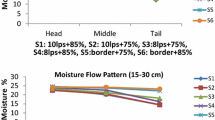Abstract
A field experiment on water management with composted coir pith and sugarcane trash under two irrigation levels (100 and 75% of recommended level of irrigation) with the aim of assessing performance of bud chip settling in 150 × 45 and 150 × 60 cm spacing was conducted in split-plot design at ICAR-Sugarcane Breeding Institute, Coimbatore, Tamil Nadu, India, during 2013–2014, 2014–2015 and 2015–2016. The soil of the experimental site was sandy clay in texture, taxonomically classified as typic haplustalf, low in organic carbon, medium in available N and available P and fairly high in K, slightly alkaline in reaction with normal electrical conductivity. The prevailing climatic condition during experimentations represented tropical Indian conditions, wherein mean temperature ranged in between 21.24 and 33.10 °C with a mean relative humidity of 54.58–85.5%. As against the normal rainfall of 674.2 mm, only 356, 537 and 679 mm of rainfall was received during 2013–2014, 2014–2015 and 2015–2016 crop seasons indicating the erratic behaviour of rainfall. The results revealed that application of 10 t/ha composted coir pith or 5 t/ha of sugarcane trash in furrow at the time of planting and scheduling irrigation in sugarcane at 75% of recommended level of irrigation saved 387, 344 and 255 mm irrigation water; in addition, it gave higher irrigation water use efficiency (0.82 t/ha/cm), net returns (99,039 Rs/ha) and benefit–cost ratio (1.79) over scheduling irrigation at 100% level. Further it was also observed that setts planting at 90 cm recorded 15.47 and 25% higher cane yield than bud chip settling planting at 150 × 45 and 150 × 60 cm, respectively. Amongst two soil moisture conservation measures, i.e. composted coir pith and trash, application tried in sugarcane conserved soil moisture efficiently and recorded higher soil moisture by 8.10 and 7.62% and cane yield 19.59 and 12.91%, respectively, over the control. Planting bud chip settling at 150 × 45 cm spacing was found superior over bud chip settling planting at 150 × 60 cm spacing. Hence for efficient water management in sugarcane under tropical Indian condition, use of composted coir pith @ 10 or 5 t/ha of chopped trash with 75% of recommended level of irrigation in bud chip settling (150 × 45 cm) planting is recommended.




Similar content being viewed by others
References
Ali, F.G., M.A. Iqbal, and K.B. Malik. 1998. To study the optimum level of irrigation and fertilizer cane varieties BL 4 and BF 162. Pakistan Sugarcane Journal of Technology 28: 129–133.
Arachchi, L.P.V., and L.L.W. Somasiri. 1997. Use of coir dust on the productivity of coconut on sandy soils. Cocos 12: 54–71.
Basnayake, J., P.A.N. Jackson, G. Inman-Bamber, and P. Lakshmanan. 2012. Sugarcane for water-limited environments. Genetic variation in cane yield and sugar content in response to water stress. Journal of Experimental Botany 63: 6023–6033.
Carr, M.K.V., and J.W. Knox. 2011. The water relations and irrigation requirement of sugarcane (Saccharum officinarum): a review. Experimental Agriculture 47: 1–25.
DAC. 2016. Natural resource management. State of Indian Agriculture 2015–16. Government of India, Ministry of Agriculture and Farmers Welfare, Department of Agriculture, Cooperation and Farmers Welfare, Directorate of Economics and Statistics, New Delhi.
Dhanapal, R., and A.S. Tayade. 2016. Cane agronomy. In Handbook on sugarcane, ed. B. Ram, T. Rajula, R. Vishwanathan, G. Hemprabha, and C. Palaniswami, 63–86. Coimbatore: ICAR-Sugarcane Breeding Institute.
Gaddanakeri, S.A., N.S. Kanbar, P.S. Biradar, and B.T. Nadgouda. 2007. Response of shy-tillering sugarcane variety CoC 671 to wide-row spacing and clipping. Karnataka Journal of Agricultural Sciences 20(3): 598–599.
Gomez, K.A., and A.A. Gomez. 1984. Statistical procedures for agricultural research. Singapore: Wiley.
Mathew, T., and K. Varughese. 2008. Effect of methods of irrigation and trash mulching on biophysico-chemical environs of soils in sugarcane agroecosystem. Sugar Tech 10(4): 308–313.
Meade, G.P., and J.C.P. Chen. 1977. Cane sugar handbook, 10th ed, 515–545. New York: Wiley.
Singandhupe, R.B., M.C. Bankar, P.S.B. Anand, and N.G. Patil. 2008. Management of drip irrigated sugarcane in western India. Archives of Agronomy and Soil Science 54(6): 629–649.
Singh, P.N., and S.C. Mohan. 1994. Water use and yield response of sugarcane under different irrigation schedules and nitrogen levels in a subtropical region. Agricultural Water Management 206: 253–264.
Singh, P.N., S.K. Shukla, and V.K. Bhatnagar. 2007. Optimizing soil moisture regime to increase water use efficiency of sugarcane (Saccharum spp. Hybrid complex) in subtropical India. Agricultural Water Management 90: 95–100.
Sivanappan, R.K. 2012. Advanced technologies in sugarcane cultivation using drip fertigation to double cane yield, save water and mitigate power shortage by producing ethanol and electricity in Tamil Nadu. Chinnavedampatti: Ramanandha Adigalar Foundation.
Stamps, R.H., and M.R. Evans. 1997. Growth of Dieffenbachia maculata Camille in growing media containing sphagnum peat or coconut coir dust. Hort Science 32(5): 844–847.
Sundara, B. 1998. Sugarcane cultivation. New Delhi: Vikash Publishing House Pvt Ltd.
Tamil Selvan, N. 2000. Effect of chip bud method of planting and nitrogen on yield and quality of sugarcane. Indian Journal of Agronomy 45(4): 787–794.
Tayade, A.S., P. Geetha, R. Dhanapal, and K. Hari. 2016. Effect of in situ trash management on sugarcane under wide row planting system. Journal of Sugarcane Research 6(1): 35–41.
Wiedenfeld, B. 2004. Scheduling water application on drip irrigated sugarcane. Agricultural Water Management 64: 169–181.
Yadav, R.L. 1991. Sugarcane production technology: constraints and potentialities. New Delhi: Oxford and IBH publishing Co., Pvt. Ltd.
Author information
Authors and Affiliations
Corresponding author
Ethics declarations
Conflict of interest
We, the authors, declare that we have no conflict of interest.
Rights and permissions
About this article
Cite this article
Dhanapal, R., Tayade, A.S., Bhaskaran, A. et al. Efficient Water Management in Sugarcane with Composted Coir Pith and Sugarcane Trash Under Tropical Indian Conditions. Sugar Tech 21, 256–264 (2019). https://doi.org/10.1007/s12355-018-0593-3
Received:
Accepted:
Published:
Issue Date:
DOI: https://doi.org/10.1007/s12355-018-0593-3




